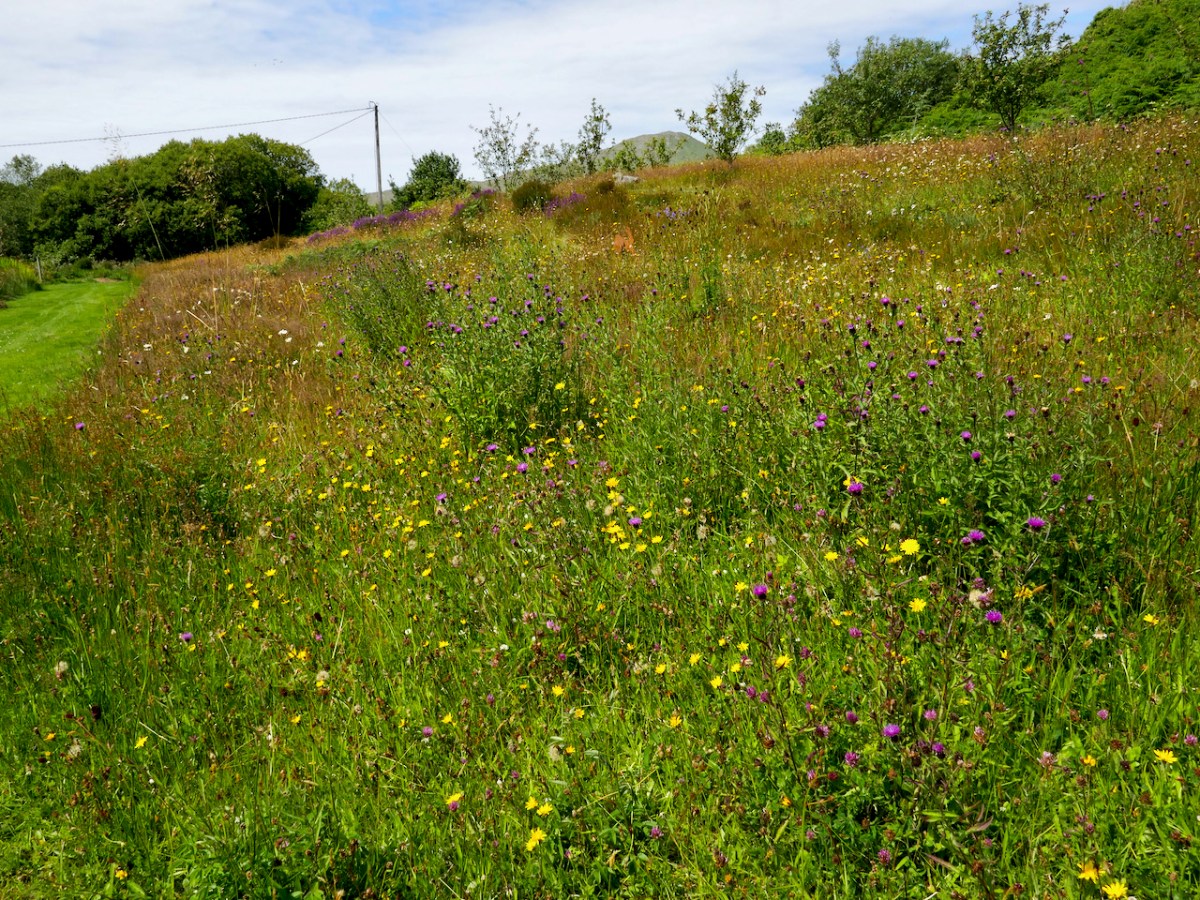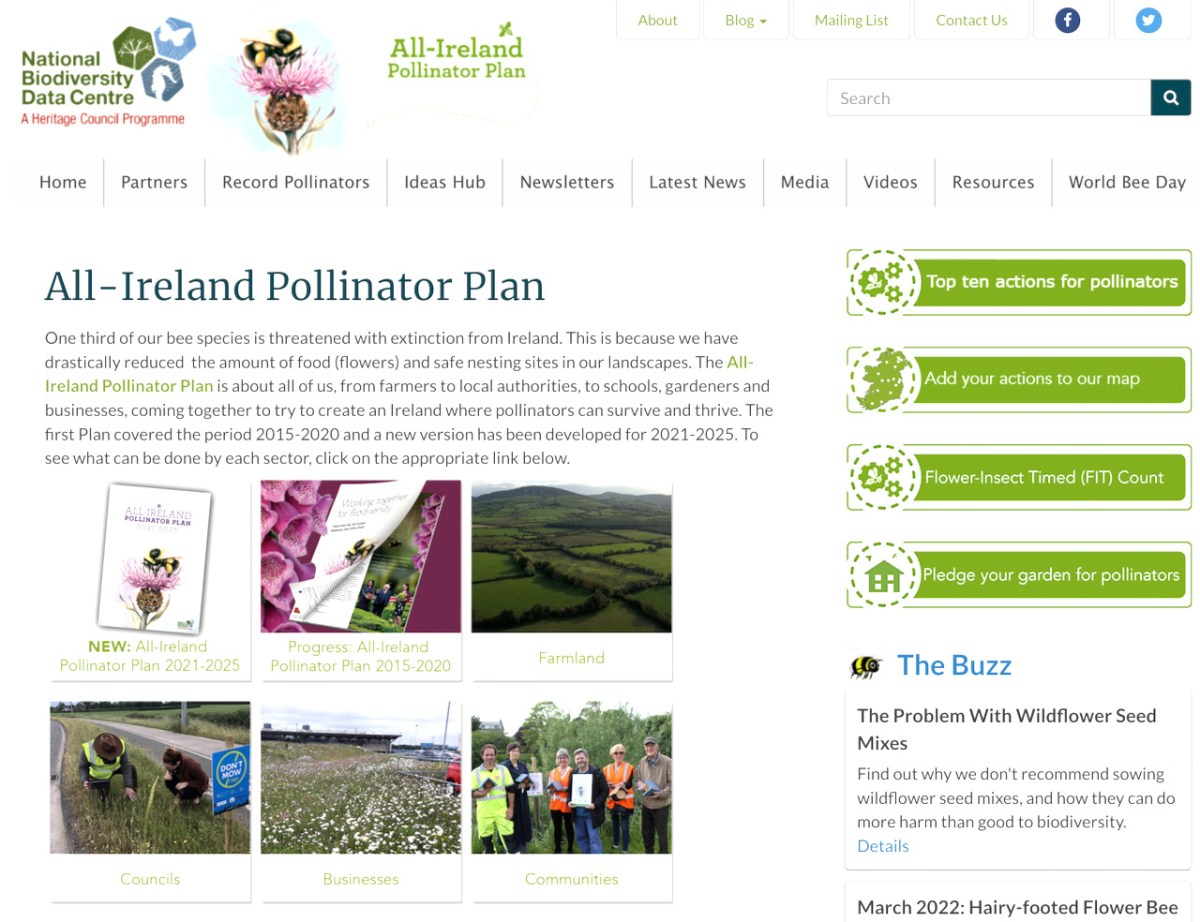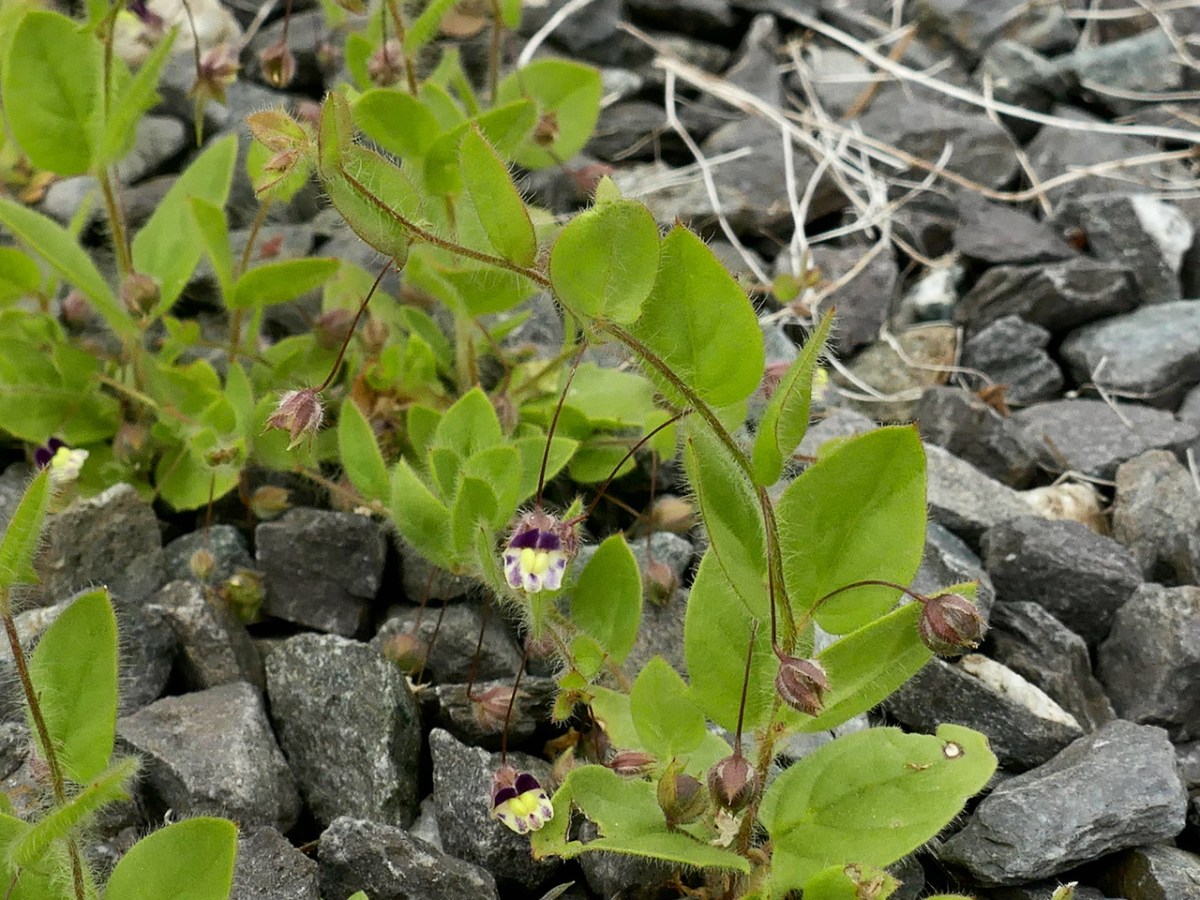
A weed is a wildflower whose name we haven’t learned yet, in the same way that a stranger is a friend we haven’t met yet. Like the hogweed above – a plant, by the way, that is in the top ten percent of the most nectar-rich and valuable-for-pollinator wild plants, a plant that is also edible by humans and animals – ‘weeds’ are plants we mostly love to hate.

Ah yes – weeds! Those wreckers of manicured lawns and tidy driveways. Those nasty undesirables that must be dug up or, as with the seldom-used holiday home above, Rounded-Up.

But wait – what’s this? All over Ireland people are letting the ‘weeds’ take over! Just look at this fabulous example at the Heron Gallery on the Sheep’s Head (above). It’s like we’ve had a mad rush of blood to the head and are changing life-long attitudes. What has caused this? Was it the pandemic, like we account for so many other changes in our lives?

Mostly, it’s down to the incredible work of the All-Ireland Pollinator Plan, a program devised by the National Biodiversity Data Centre and two lead researchers, Dr Úna FitzPatrick of the Centre and Prof Jane Stout of Trinity College. (I had the immense pleasure of a day with Úna recently.) It’s been very successful, with many county and town councils signing up and pledging to implement pollinator-friendly horticultural and agricultural practices. For the last few years, The National Tidy Towns Handbook is on board too, with an emphasis on native species and pollinator-friendly planting.

And this is urgent!
Pollinators are in decline, with one-third of our 98 wild bee species threatened with extinction from the island of Ireland. The problem is serious and requires immediate attention to ensure the sustainability of our food, avoid additional economic impact on the agricultural sector, and protect the health of the environment.
Working together for Biodiversity:
Tales from the All-Ireland Pollinator Plan 2015-2020

Each of us with any little patch of ground can do our bit too. All you have to do is set aside whatever portion of your garden you’re comfortable with (10%? 50%?) and turn it into a perennial wildflower patch. I’ve been doing this in my garden (above) now since 2017, so this is my 6th year. in 2018 I introduced Yellow Rattle from seeds bought from Sandro Cafolla at The National Wildflower Seed Collection. Called the meadow maker, Yellow Rattle (below) parasitises on grass roots, thinning them out and providing space for other wild seeds to take root. Apart from that, I have had to keep an eye on incursions of bracken and nettles.

The results have been all that I hoped for. Every day I am tempted out to my little mini-meadow with my camera. The rest of the lawn I try to leave as long as possible between cuts and it’s amazing what comes up there too. Take a look at my video, Lying in the Grass, for a sense of the sheer wonder and variety of what has appeared all over my One Acre.
The driveway and all around the house is gravelled and I have resisted the temptation to tidy it up in any way. In return, a huge variety of wildflowers have appeared – Groundsel and Pineapple-weed, Scarlet and Yellow Pimpernel, Silverweed, Cat’s-ear and Autumn Hawkbit, Germander and Thyme-leaved Speedwells, Herb-Robert and Keel-fruited Cornsalad, Dove’s-foot and Cut-leaved Crane’s-bills, Common and Bush Vetch, Sowthistles (Prickly and Smooth), Sheep’s-bit, Sorrels and Chamomile.

I even discovered a rare little plant popping up in my driveway – the gorgeous and curious Sharp-leaved Fluellen. According to the distribution maps it’s been slowly making its way west from Wexford over the years – but how on earth did it land in my driveway? It’s a mystery like that, that keeps me fascinated with wildflowers.


See what I did there? I named the ‘weeds’ – and naming something gives it presence and personality. Once you know the name, there’s a natural curiosity to know more about the plant itself and to keep an eye on it. Thus, they turn into old friends and your heart lifts as you watch a Painted Lady Butterfly feeding on the humble Knapweed, or a Bumble Bee hover over the vetch, choosing which blossom to settle on.


We need to adjust our notions of what’s beautiful if we are to avoid a biodiversity catastrophe. Each one of us can do something to help. If you want to grow your own perennial wildflower patch, there are simple steps you can take – see my posts on my One Acre (then, One Year on, Three Years on, and Four Years On) for what I have done, or follow the Guidance of the Pollinator Plan.

Here’s what NOT to do – don’t buy ‘Bee Bombs’ or packets of ‘wildflower mix’ seeds. As this excellent paper puts it: Wildflower seed mixtures do not help address biodiversity loss. Rather, they cause further disruption to what remains of the natural environment. Follow best practice – mow once a year and remove the cuttings, try to keep down nettles, dock and bracken (and Ragwort if it’s threatening to take over) – and then let it be. Every now and then, go lie down in the grass beside it and listen for buzzing.

And if you’re a keen gardener and want to just make your garden more pollinator-friendly – there’s a guide for that too!
As you know, we’re all for a bit of wildness! Some great photos, especially the bog pimpernel.
LikeLike
Your wildness beats mine!
LikeLike
Well done and well said Finola. Certainly I find a new and growing awareness over these matters. People can actually talk about pollination, going easy with the scythe and mower, diversity in the countryside, without being thought potty. Similarly, veganism (with its many health and environmental benefits as well as moral compass) is no longer the outpost of a few loonies. I wonder if we’re starting to turn a corner? Once nature is given half a chance it starts regaining lost ground.
LikeLike
Thanks, Roy, and yes, it’s very heartening, isn’t it?
LikeLike
Finola, thank you for this wonderful article on ‘weeds’! It’s been such a pleasure to read and to watch the video. Your photography is stunning! I’m doing the WildWork’s biodiversity programme at the moment and endeavouring to let some places in the garden go wild. I’ve found that hares are living right up against the house where I’ve let the ‘beds’ go wild naturally. What’s fascinating is that I’ve been looking at the patch of ground, seeing nothing and then a hare pops up and runs off. Another reason to let nature flourish. Keep up your great posts! All the best, Ann
LikeLike
Thanks so much, Ann! We are jealous of your hares! We’ve had a hare visit once or twice, but so rarely. Bunnies do put in an appearance often, though.
LikeLike
That Fluellen is divine! I’ve never seen one in the flesh and would love to. I imagine it came in with the stone on the drive, a possibility at any rate. There is a great move towards incorporating native plants in the garden and it is very worthwhile.
LikeLike
Yes – I note Bantry House has let much more wildness creep in now. I am thrilled with my Fluellen.
LikeLiked by 1 person
Great post and a lovely video. We moved to West Cork from Kildare just over a year ago. I’ve wanted to let the grass grow for years but in a small town garden it just looks like a mess. I rebelled from time to time in May, to allow the buttercups to grow. Other than that, it was fairly pristine with mainly plants and very little lawn. There were all sorts of bees, wasps, hover flies etc. Since our move, it gave me the opportunity to let it grow because we have just under an acre now. I’ve mowed paths all around the garden which our lab loves to wonder through, and take in all the plants that appear through the seasons. It’s a year and 3 months now since we moved in. Several people have commented, and wondered what I was doing. But I get the impression they are confused by the fact that it actually looks pretty good. There was a plant you named to weaken the grass roots, I’ll take a look at that and try to introduce it.
Can I ask, was the music in the video Mícheál Ó Súilleabháin? Sounded like him. Could you give me the name of the piece please?
Thanks,
Paul
LikeLike
Glad to hear I have a mow-averse reader! If you click on the YouTube link in the video, and then scroll down in YouTube, you should see all the music details and copyright details. Good ear! It is indeed Turas Go Tir Na Nog
by Mícheál Ó Súilleabháin from his album Templum.
LikeLike
Thank you for this timely reminder of the importance of pollinators. The link at the end led me to SurveyMonkey and I can’t see its relevance? I’d like to purchase charts of pollinators but it is not clear if there is a national organization selling such material? Can you help, please? Thanks.
LikeLike
Replied by email.
LikeLike
Glorious
LikeLike